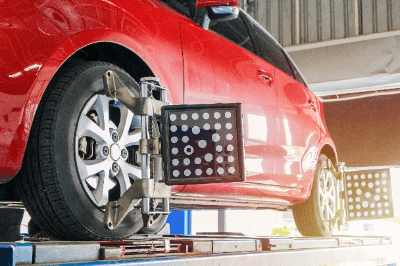What Is an Alignment Tester?

An alignment tester is a device used to measure and adjust the wheel alignment on vehicles.
Wheel alignment involves the accurate adjustment of the angles of a vehicle’s tires, which is crucial for ensuring even tire wear and optimal handling.
Uses of Alignment Testers
Alignment testers primarily ensure a vehicle’s wheel alignment is accurate, serving several vital purposes:
1. To Ensure Safety by Improving Driving Stability and Handling
Correct alignment enhances vehicle stability and handling, reducing the risk of accidents by making it easier to control and maneuver, especially during sudden directional changes.
2. Even Tire Wear
Improper alignment leads to uneven tire wear, decreasing tire lifespan. Properly aligned wheels ensure even tire wear, extending their service life.
3. Improved Fuel Economy
Incorrect alignment increases tire rolling resistance, which can worsen fuel efficiency. Accurate alignment optimizes tire angles, improving fuel economy.
4. Tire and Suspension Protection
Continued misalignment strains tires and suspension components, potentially causing premature failure and damage. Proper alignment mitigates these risks.
Principle of Alignment Testers
Alignment testers commonly employ sensors or lasers to ascertain the position and angle of tires and wheels. Sensors placed at strategic points measure distances and angles to evaluate vehicle alignment.
When lasers are used, a reflective device mirrors the laser back, allowing the measurement of alignment parameters based on the reflector’s distance and angle.
Key alignment parameters include caster, camber, and toe—caster relates to the wheel’s vertical axis tilt, camber to the tire’s tilt, and toe to the tire angle orientation. Precise measurement of these parameters reveals the vehicle’s alignment state.
Vehicles are positioned on a measurement platform, with sensors and lasers attached to various parts for data collection. This data is then analyzed by specialized software to assess the vehicle’s alignment.
Types of Alignment Testers
Alignment testers are categorized as follows:
1. Optical Alignment Tester
Utilizes laser or optical technology to gauge vehicle wheel alignment. Reflectors attached to each tire enable the measurement of alignment angles and positions at high speeds.
2. 3D Alignment Tester
Employs 3D cameras and sensors for precise position and angle measurements of each tire. This method uses 3D modeling for real-time data analysis and simultaneous measurement of multiple alignment parameters, boasting high accuracy and speed.
3. Sensor Type Alignment Tester
This tester uses sensors fixed to the tires and wheels to measure alignment. The direct attachment to the vehicle ensures high measurement accuracy.
4. Head Type Alignment Tester
Features a measuring unit, or “head,” attached to the wheel to assess alignment parameters, providing high accuracy due to the direct contact with each tire.
5. Incremental Alignment Tester
Utilizes incremental sensors or gyroscopes to measure vehicle inclination or angles, ideal for assessing camber and caster parameters.
With various alignment testers available, selecting the appropriate one is crucial for precise alignment measurements.